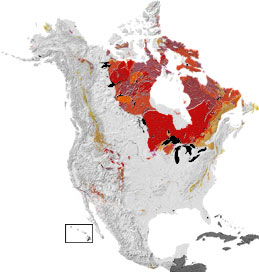|
|
Paleontology and Paleoclimate: Earth was formed approximately 4.5 billion years ago (bya). For nearly 4 billion years after that, or roughly seven-eighths of the Earth's history, the only living things on Earth were single-celled organisms. This immense stretch of time is called the Precambrian, which can be divided into two eons: the Archean (approx. 4 bya to 2.5 bya) and the Proterozoic (2.5 bya to 543 million years ago). Some of the most important events in biological history took place during the Precambrian. Consider that the Earth formed, life originated, the first tectonic plates formed and began to move, eukaryotic cells evolved, the atmosphere became enriched in oxygen—and just before the end of the Precambrian, during a time interval called the Ediacaran (600-542 million years ago), complex multicellular organisms, including the first animals, evolved.
Paleogeography: Rodinia, the oldest supercontinent for which we have some record, formed during the middle Proterozoic (~ 1100 million years ago) with North America in the center, South America to the east, and Australia and Antarctica to the west. When the Panthalassic Ocean formed about 750 million years ago, Rodinia was split into two parts. One part (North America) moved south, crossing the pole, while the other (Antarctica, Australia, India, Arabia, and parts of China) headed toward the North Pole. By the end of the Precambrian (~ 600 million years ago), these two parts collided with the newly formed Congo craton (north-central Africa) and formed the supercontinent Pannotia.
|
|
 |
 |
 |
 |
|
North America Today

Most of what we know as present-day North America was underwater during the Precambrian. Later, limestones, sandstones, and shales were deposited on top of the Precambrian deposits, as North America was periodically covered by shallow seas or received sediments from higher ground. Several continental collisions pushed Precambrian basement rocks up, exposing them in mountainous regions like the Rockies and the Appalachians, as well as in the Canadian Shield (throughout Wisconsin, Minnesota, Michigan, New York, and East Central Canada). However, Precambrian rocks underlie the majority of North America today.Zoom map
|
|
 |
 |
|
 |
See the Precambrian in:
Or jump to another period:
|